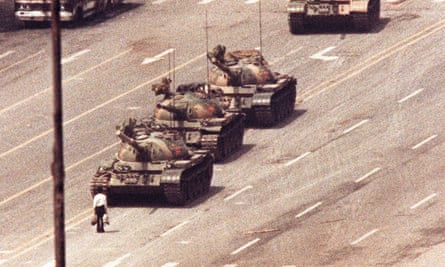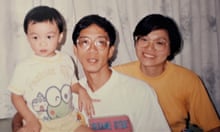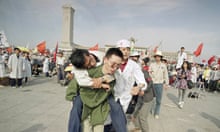What sparked the pro-democracy protests in 1989?
In April 1989, the popular reformist leader Hu Yaobang died. During the 1980s he had been a high-ranking Communist party official who had promoted economic and political reform, but was ousted by his conservative opponents. Two days after his death, on 17 April, several hundred students marched to Tiananmen Square and laid a wreath at the Monument to the People’s Revolutionary Heroes. They called for greater freedom of speech, economic freedoms and curbs on corruption – demands that touched a raw nerve with the conservatives in the Communist Party. The top leadership was divided; while some saw students as patriotic, others saw them as a threat to the regime. The demonstrations spread to hundreds of cities across China.
How did the authorities respond?
On 26 April, an editorial in the Communist Party’s People’s Daily denounced the student demonstrations as a “premeditated and organised conspiracy and turmoil” with “anti-party” and “anti-socialist” motives. The next day, tens of thousands of students in Beijing staged a demonstration to protest against the editorial. Communist Party chief, Zhao Ziyang, a liberal, tried to mitigate the damage by indicating his willingness to hold a dialogue with the students in a speech on 4 May. On 13 May, just two days before the arrival of Soviet leader, Mikhail Gorbachev for a state visit, hundreds of students began a hunger strike in Tiananmen Square. The protests forced the cancellation of the welcoming ceremony. On 19 May, in his last public appearance, Zhao visited students before dawn and made a tearful plea for them to leave the square. Zhao was later purged and lived under house arrest until his death in 2005. On 20 May, martial law was declared in parts of Beijing. Troops moved in, but were blocked by the civilians and demonstrations continued.
What happened during the crackdown in the square?
In the early hours of 4 June, Chinese troops launched a two-pronged attack from the east and west of Beijing with orders to put down the protests. The Guardian’s China correspondent at the time, John Gittings, reported that hundreds of army trucks moved up Beijing’s main avenue from the west while soldiers on foot shot to kill from both sides. Armoured cars and tanks also smashed through the citizens’ barricades to the east. Gunfire was heard throughout the night. Some forty workers who went to plead with the soldiers were shot. “When a government uses tanks to declare war on its people, anything is possible and the people now know it,” Gittings wrote. On 5 June, an unidentified young man stood in front of a tank convoy leaving Tiananmen Square, in a final act of defiance.

After the crackdown, the authorities put student leaders, outspoken liberal intellectuals and workers who played a key role in the movement on its most-wanted list. A number fled to western countries via Hong Kong, but many were arrested and jailed on “counter-revolutionary” charges.
How many people were killed?
The actual number of deaths from the crackdown remains unknown, but according to a secret diplomatic cable from then British ambassador to Beijing, Sir Alan Donald, dated 5 June, 1989 and released in December 2017, the Chinese army killed at least 10,000 people. This death toll is much higher than previously cited estimates, which ranged from hundreds to about 3,000.
How does China deal with the legacy of the Tiananmen Square?
Thirty years on, the Chinese authorities continue to view the Tiananmen protests as one of the most sensitive and taboo subjects. “June 4”, as the movement is commonly known as in China, remains largely scrubbed from official history and is censored from school text books and online. The authorities punish those who try to commemorate the event, placing scores of intellectuals, writers or activists under house arrest ahead of the anniversary of the crackdown. Relatives of the victims who died during the massacre are barred from openly mourning their loved ones.
In the three decades since Tiananmen, the Communist Party has rejected calls for political liberalisation, tightened its control on speech and intensified its suppression of dissent to maintain stability and to uphold its own survival. The repudiation of political transparency ushered in an era of rampant corruption, inequality and social instability. The Chinese government has since justified its military crackdown on the movement as necessary for political stability, economic prosperity and its eventual rise.









